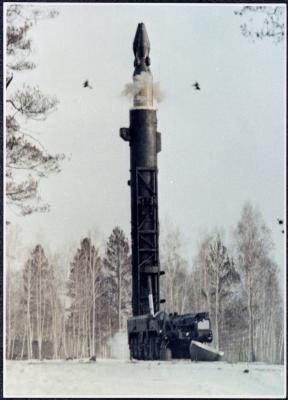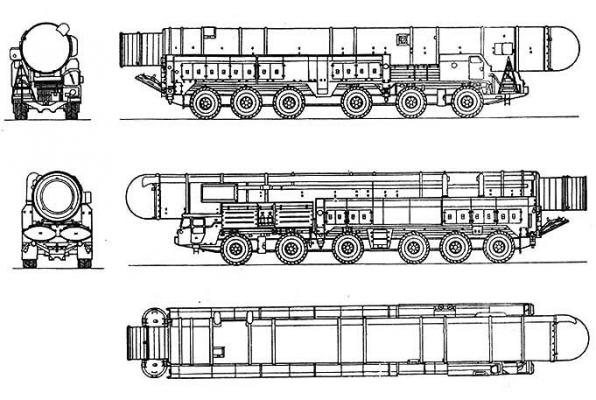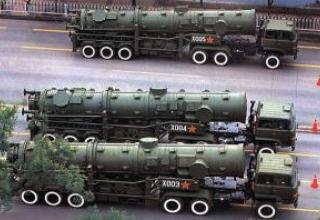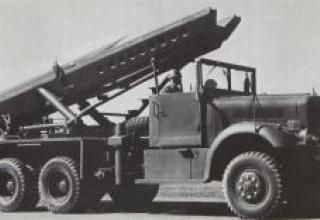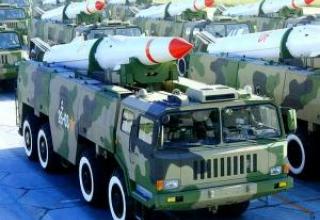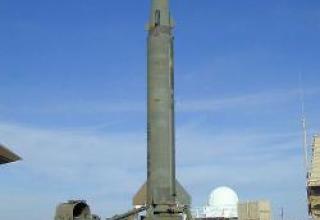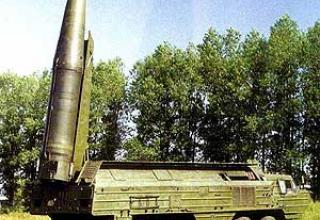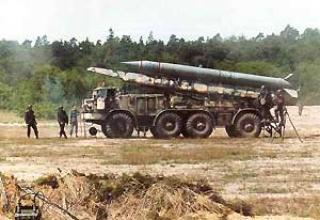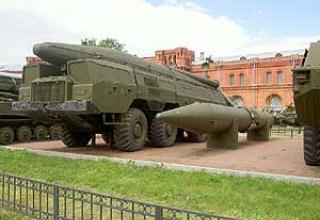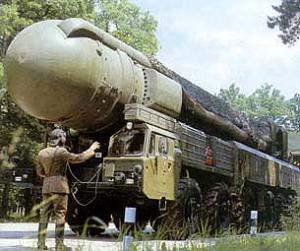
The design of the Pioneer complex with a medium-range solid propellant rocket began in 1971 at the Moscow Institute of Heat Engineering under the leadership of Academician A. D. Nadiradze. The new missile (factory designation 15Zh45) was created on the basis of two upper stages of the intercontinental ballistic missile of the Tempe-2C complex. Re-engineered: thrust cut-off unit of the second stage propulsion system, connecting compartment and separating HC missiles.
After the practical development of various technical solutions for the new missile and ground units of the missile system September 21, 1974 at the test site Kapustin Yar began flight tests. It took almost a year and a half to complete the development of the system and implement the planned test programme. On March 11, 1976, the State Commission signed an act of acceptance of the Pioneer complex with a 15G45 missile (RSD-10) into service of the Strategic Missile Forces.
Some of the obsolete medium-range missiles, primarily R-14, were removed from service, and their place was taken by the Pioneers. The appearance of the latter caused great turmoil in NATO countries, and very quickly the new Soviet missile became known as the SS-20 - "Thunderstorm of Europe".
August 10, 1979 for flight tests was presented missile 15Zh53, which had higher combat characteristics. Tests were conducted at the Kapustin Yar range until August 14, 1980, and on December 17 of the same year the new complex, designated "Pioneer UTTH" (improved tactical and technical characteristics), was adopted by the Strategic Missile Forces. The 15Zh53 missile had the same first and second stages as the 15Zh45 missile. Changes were made to the control system and the instrument cluster. Due to improvement of command devices and algorithms of BTWC operation, it was possible to increase accuracy of firing up to 450 m. Installation of new engines with increased power on the instrument cluster made it possible to increase the area of deployment of combat units, which was very important when planning the targets. Besides, the maximum firing range was increased up to 5500 km.
In 1987, 650 missiles were on combat duty and in the arsenals (see photo1, photo2). Of these, two thirds were intended for the destruction of facilities in Europe and the Middle East and about one third for the destruction of facilities in Asia and the United States.
Both facilities were operated until 1991 and were dismantled in accordance with the terms of the DSM Treaty. The first missiles were destroyed in the Chita region by launching. Of particular interest were the Pioneer missiles, which had been in operation for over 10 years. The launches were successfully completed. Later in the area of the Kapustin Yar range another technology of liquidation was applied - explosion of rockets without taking them out of launch containers. The chassis of the launchers of the complex after passing a special procedure of dismantling, which excludes their main purpose, can be used in various variants in the national economy.
The last RSD-10 missile was destroyed on May 12, 1991. Several launchers and missiles have been preserved as exhibits in museums in the country and abroad.
Composition:
The Pioneer missile system includes the following combat vehicles:
- 15G45 rocket. (15G53) (see layout diagram)
- launcher
- Transportation and loading vehicle (TPS)
The 15Zh45 missile had two marching steps and an aggregate-device unit with a head end, which were connected to each other by connecting compartments.
The first stage propulsion system was a design consisting of a fiberglass body with a solid fuel charge fastened to it, made of high-energy blended fuel, steel front end and nozzle cover, and a nozzle block. The tail compartment of the stage housed brake engines and steering gears. Control forces created four gas-dynamic and four aerodynamic rudders (the latter are made in the form of grilles).
The second stage engine had a similar design, but other methods were used to obtain the steering forces. Thus, the control of the angles of pitch and yaw was carried out inflatable gas from the gas generator in the critical part of the nozzle, and on the heels - by blowing gas through a special device. Both engines had a thrust cut-off system (on the first stage - emergency) and operating time of about 63 seconds. The engine is switched off by opening ten additional holes located on the front bottom of the combustion chamber, the pressure drops sharply and the combustion of solid fuel stops.
The missile control system, developed under the leadership of Academician N.A. Pilyugin, with an on-board computer, allowed the missile to be in a horizontal position during the course of the combat duty, ensured the accuracy of hitting (CVO) not worse than 500 m in the entire range of ranges and azimuths without turning the launcher, full automation of prelaunch preparation and launch, as well as automatic routine checks. All main units had redundancy, which ensured high reliability of operation, and were located in an airtight instrument compartment.
The missile carried a separable MIRV-type head unit with three combat units of 150 kt each with individual pointing at their own targets. The dilution stage included a control system and a solid propulsion system. No aerodynamic fairing was provided for the head unit. To reduce aerodynamic loads in flight, the warheads were mounted at an angle to the missile's longitudinal axis. The missile did not have the complex of overcoming the missile defense system.
There were 3 versions of the RSD-10 missile:
- Mod 1 - with monoblock head unit and a firing range of 5000 km,
- Mod 2 - differed only in combat equipment - had a splitting head unit (DHU) with 3 individually guided combat units (IHUs). (this is the main variant that gained the most popularity).
- Mod 3 - tested in May 1985 and sometimes referred to as SS-X-28 in the West - had a lightweight 50 kt monoblock head unit and an extended range of 7,400 km - did not leave the test phase.
In the course of operation, the missile, placed in an airtight transport and launch container, was placed on a self-propelled launcher (SPS), made on the basis of a six-axle vehicle chassis MAZ-547. In addition to the rocket on the chassis were the necessary units and equipment to monitor the technical condition of the rocket and the launch. Despite the solid weight (more than 80 tons) and dimensions (length - 19.3 m), the LPU had a relatively high speed, traveled on roads with any surface, easily overcome metre fords and climbs up to 15 degrees. and had a turning radius of 21 m, which allowed the widespread use of the existing road network.
The rocket could be launched either from a special garage shelter at the main position (the Krona structure) or from one of the prepared field positions. Before that, the launcher was jacked up and horizontally positioned. The missile was launched using a gunpowder pressure accumulator, which ejected it from the container. After reaching a safe altitude, the first stage marching engine was engaged. The prelaunch and launch operations were carried out automatically after receiving a special command from the control room.
The "Krona" structures were intended primarily to exclude the possibility of permanent control of the "Pioneer" complexes by the means of potential enemy intelligence. The "Krona" is a prefabricated structure of metal structures. The structure is a gateway, that is, the gate is located on both sides, which makes it possible to abandon complex maneuvering for heavy vehicles. Along the walls of the structure there are electric furnaces of SCB type. Thus, it is impossible to determine with the help of thermal imaging sensors whether the launcher is in the structure or not. It is possible to launch the missile without leaving the structure. This is done by detonating the pyropatrons, which throw the roof sectors aside. After that, the container is lifted and the missile is launched. Since the launcher is already jacked when in the structure, the preparation time for launch is reduced. On the route of the missile regiment column provided for several similar structures, which demanded to mislead the enemy.
Characteristics:
| Mobile ground missile system "Pioneer" | |
| Developer | MIT |
| Chief Designer | A.D.Nadiradze |
| Missiles manufacturer | Votkinskiy MZ |
| NATO Code | SS-20 Saber Mod 1&2 |
| Name by DSMD | RSD-10 |
| Complex type | Mobile missile system with medium range, third generation ballistic missile system |
| Status | In service since March 11, 1976. |
| 15G45 rocket. | |
| Range of fire, km | 600-5000 |
| Firing accuracy (CWO), km | 0.55 (limit deviation - 1.3) |
| Type of HF | Monoblock thermonuclear (on tests - variant 1) |
| Type of HF | Three-unit RPG (Option 2) |
| Charge power (option 1), Mt | 1,0 |
| Charge power (option 2), Mt | 0,15 |
| Weight HF, kg | 1500-1740 |
| Control System | Inertial with gyrostabilized float gyro platform, with BCVM |
| Designer of a control system | AP RESEARCH INSTITUTE |
| Chief Control System Designer | N.A.Pilyugin |
| Steering actuators | Hydraulic |
| Designer of steering gears | CNIIAG |
| Controls on 1 stage | Gas and aerodynamic grating rudders, grating stabilizers |
| Controls on 2 steps | By pitch and yaw - blowing into the critical part of the hot gas nozzle; by roll - gas nozzles with gas generator. |
| Type of start | "Mortar" from the TIC. |
| Number of steps | 2 |
| The full length of the rocket, m | 16,49 |
| The length of the missile without the head end, m. | 14,9 |
| The length of the missile in the TIC, m | 19,32 |
| Maximum housing diameter, m | 1,79 |
| Start weight, t | 37,0 |
| Weight of the missile in the TIC, t | 42,7 |
| Fuel | Mixed solid |
| First step | |
| The full length of the first stage, m | 8,58 |
| Maximum first stage housing diameter, m | 1,79 |
| Step weight, kg | 26,7 |
| Engine | Single-Camera RDTT |
| Engine Designer | NGO "Soyuz" (Lyubertsy) |
| Chief Engine Designer | B.P.Zhukov |
| Number of nozzles | 1 |
| Working time, s | 63 |
| Second step | |
| The full length of the second stage, m | 4,4-4,6 |
| Maximum second stage housing diameter, m | 1,47 |
| Step weight, kg | 8,63 |
| Engine | Single-Camera RDTT |
| Engine Designer | NGO "Soyuz" (Lyubertsy) |
| Chief Engine Designer | B.P.Zhukov |
| Number of nozzles | 1 |
| Battle Stage | |
| Number of combat units | 3 |
| Motor unit | four RDTTs |
| Battle Block | |
| The full length of the combat unit, m | 1,6 |
| Maximum hull diameter of combat unit, m | 0,64 |
| Curvature radius tip | 0,11 |
| launcher | |
| Type | Dirt mobile |
| Developer | Central Design Bureau "Titan" |
| Manufacturer | barricade factory |
| Chief Designer | V.P.Barmin |
| Length, m | 3,05 |
| Width, m | 3,05 |
| Height, m | 3,30 |
| Number of missiles on the launcher | 1 |
| Lifting drive type TPK with rocket | Hydraulic |
| Lifting drive developer with a rocket | CNIIAG |
| U-turn radius, m | 21 |
| Crew, man. | 3 |
| Transportation and loading vehicle (TPS) | |
| Developer | Central Design Bureau "Titan" |
| Manufacturer | Barricade factory |
| Base | MAZ-547A |
| Number of axles | 6 |
| Full length, m | 17,33 |
| Width, m | 3,2 |
| Height, m | 2,9 |
| Engine | Diesel |
| Power, HP. | 746 |
| Maximum speed, km/h | 40 |
| Number of missiles at the SCC | 1 |
| Crew, man. | 2 |
Testing:
Flight tests of RSD-10 missiles began in September 1974 at the Kapustin Yar proving ground. In 1977, immediately after the complex was adopted for service by the USSR Strategic Missile Forces, its deployment began. The first missile regiment with the Pioneer complex went on combat duty on August 30, 1976 (Petrikov district, Gomel region commander A.G. Doronin). Mass deployment of the "Pioneer" complex began in 1978 in the position areas previously occupied by obsolete complexes with missiles R-16. Each missile regiment consisted of 6-9 self-propelled PU, provided with individual protective structures.
According to American data, the largest number of deployed launchers was 441 in 1986. According to the Soviet official data given in the Memorandum of Agreement on the Establishment of Initial Data in connection with the treaty between the USSR and the United States on the elimination of medium- and shorter-range missiles, as of November 1, 1987 in the USSR was deployed 405 RSD-10 missiles, another 245 ballistic missiles were in storage.
During the 15 years of operation, there have been no missile failures or accidents. During testing, operation and liquidation 190 missiles were fired. All the launches were successful. At the same time, the probability of hitting the target left 98%.
Sources:
- Колесников С.Г. "Стратегическое ракетно-ядерное оружие", Москва, Арсенал-Пресс, 1996 г.
- Карпенко А.в."Отечественные стратегические ракетные комплексы", 1996 г.
